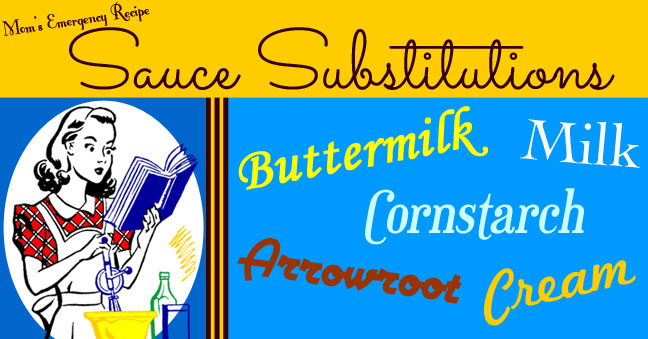Contents
- Mom’s Emergency Sauce Recipe Substitutions and Cooking Tips for: Milk, Buttermilk, Cream, Cornstarch & Arrowroot
- Milk Recipe Substitutions
- Buttermilk Recipe Substitutions
- Whipping Cream Substitutions
- Light Cream Substitutions
- Cornstarch Recipe Substitutions
- Arrowroot Sauce Recipe Substitutions
- Cooking Tips for Fixing Watery Soups or Stews
Mom’s Emergency Sauce Recipe Substitutions and Cooking Tips for:
Milk, Buttermilk, Cream, Cornstarch & Arrowroot
Suddenly discovering you don’t have an important ingredient is no fun when you are in the middle of cooking your favorite sauce recipe. Neither is running out to the store at midnight. If you are missing an ingredient knowing its “equivalent” or substitution can help to save the day.
Adapting recipes from antique cookbooks can also cause confusion. What is arrowroot and must I consult a wizard?
Today, Mom helps cooks with sauce recipes and sauce-thickener tips for milk, cream types, buttermilk and other ingredients like arrowroot and cornstarch, all used to thicken your homemade sauces, soups and stews.
Milk Recipe Substitutions
If you don’t have one cup of fresh milk, substitute 1/2 cup of evaporated mile plus 1/2 cup of water. Or follow the directions on a box of powdered milk.
It’s a good idea to have a can of evaporated milk handy for emergencies. If you don’t use it during holiday baking, keep it for your other emergency kit.
Buttermilk Recipe Substitutions
Also called sour milk, is used to give recipes a little zip. Substitute 1 tablespoon of lemon juice or vinegar plus enough whole milk to make 1 cup (let stand 5 minutes before using),
OR use 1 cup whole milk plus 1 3/4 teaspoons cream of tartar OR use 1 cup of plain yogurt.
Whipping Cream Substitutions
Whipped cream from scratch is worth the work. If you don’t have time, just use frozen dessert topping. 1 cup of whipping cream equals 2 cups of dessert topping.
Light Cream Substitutions
If you don’t have 1 cup of light cream use 1 cup minus 2 tablespoons of milk plus 2 tablespoons of melted butter.
Cornstarch Recipe Substitutions
Cornstarch is great for thickening sauce recipes; if you don’t have 1 tablespoon of corn starch use 2 tablespoons of flour.
Cornstarch sauce tip: Always dissolve cornstarch and flours in a little water, broth or juice before you add it to your sauce to avoid lumps.
Arrowroot Sauce Recipe Substitutions
Not a mystical ingredient but another thickening agent for sauces and soups. Substitute 2 tablespoons of regular flour or 1 tablespoon of cornstarch instead of arrowroot. Dissolve it in a little water or broth first for easier mixing and to avoid lumps.
As a general rule if you are baking in the oven, you must follow the recipe as closely as possible.
Not only do your ingredients add flavor, they also serve a specific function like making your bread rise, or binding ingredients together.
If you are using milk or cream in a sauce, you have more flexibility. For example, if you are making gravy, a splash of milk instead of cream is fine. The fat content should only effect the flavor of your sauce, not the final product.
Cooking Tips for Fixing Watery Soups or Stews
If you decide your soup or stew is a bit thin, runny or it just has too much water, here are a few easy sauce cooking tips to make a broth seem richer and thicker.
Flour: Two tablespoons of flour will help thicken up a thin soup or stew quickly. Simmer for a few minutes after adding it. Pro Tip: Dissolve your flour in a few tablespoons of liquid before adding it to your sauce to avoid lumps.
Rice: A 1/4 cup of rice will soak up about 1/2 cup of liquid and will yield about 1/2 cup of rice. Rice is a nice addition to Turkey Soup. Rice needs about 20 minutes to cook while your soup is simmering.
Barley: Call in the big guns if you decide you have way too much liquid. 1 cup of barley will soak up 3 cups of liquid. However, Pearl Barley needs 45 minutes to one hour to cook. Quick cooking barley is ready in about 15 minutes. Barley goes well in hearty soups with beef or pork. Delish!
Experimental Sauce Thickener Tip: If you decide you don’t want to add rice or barley to your sauce, put it in a metal tea strainer, or tie it up in a scrap of cheesecloth. It should soak up the extra liquid, but stay in your strainer for easy removal. Your results may vary, so you may need to experiment – and let me know what worked!
Next Page:
Previous Page: Really Lazy Food: Easy Salads and Sandwiches
